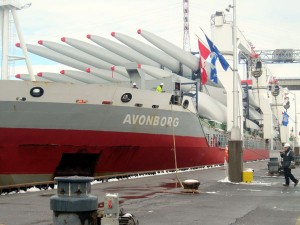A safe Seaway?
 This morning on The 8 O’Clock Hour, I reported on the balance between economic and environmental concerns on the St. Lawrence Seaway. After all, what’s known as the “Seaway” is our St. Lawrence River and Great Lakes, the world’s largest store of fresh water.
This morning on The 8 O’Clock Hour, I reported on the balance between economic and environmental concerns on the St. Lawrence Seaway. After all, what’s known as the “Seaway” is our St. Lawrence River and Great Lakes, the world’s largest store of fresh water.
There’s another element to the Seaway story. Is it safe?
At this hour, a freighter is grounded in the channel right by the Montreal waterfront. It’s carrying mechanical parts. According to the Seaway’s release:
At approximately 3:13 a.m. on Thursday, March 31, the BBC Steinhoelft veered off course and became grounded in the South Shore Canal between the St. Lambert Lock and the Jacques Cartier Bridge. No pollution has been reported as a consequence of the grounding.
A grounding 9 days into the Seaway’s 53rd season isn’t exactly what the shipping industry was hoping for.
There were at least a couple groundings in the narrow channel along the St. Lawrence River last year. (Not to mention this horrific story when gas leaked into the living quarters on a ship.) And we all know about the devastation of the Slick of ’76 (and many of us remember it firsthand).
Seaway officials say GPS and other new technological advancements have made navigation safer than ever. Ships with potentially hazardous cargo are double-hulled and must submit special safety plans. The Seaway has orchestrated emergency response trainings.
But watchdog groups like Save the River insist it’s still too dangerous. Another oil spill, or a leak of toxic chemicals, could destroy the River for years, if not decades. And green groups – and native tribes – across the Great Lakes are protesting the planned shipment of radioactive waste through the Seaway to Sweden.
What do you think? Is the Seaway critical enough infrastructure to justify the risk? Is the risk adequately managed? Or is the ecosystem too delicate to justify the risk?
Tags: infrastructure, Jefferson county, seaway, st lawrence county, st. lawrence river, st. lawrence valley, thousand islands, transportation








I can’t believe that we don’t have technology that can quickly contain a spill on a narrow water body like this?
It’s a non-issue. No matter what the cargo someone will be against shipping it and no matter what the mode of transport someone will be against it. A ship is safer than a train which is safer than a truck which is safer than a plane. I suppose we could bring back 20 mule teams and try that but then the animal rights groups would be mad.
Sometimes it just ends up being whining.
What is interesting is that the train that runs right through the middle of Canton carries tons of toxic chemicals. It derailed in the village this winter; luckily the cars that derailed were not the Chlorine gas tanker cars.
Are they double hulled etc.?
There will always be accidents the issue is the risk and the mitigation in place. But sooner or later there will always be an accident.
Mervel you’d have to check with the Haz Mat regs books but I’m pretty sure tank cars for trains are overbuilt just like over the road tanks our trucks pull. The USDOT is pretty strict as far as that type of thing goes.
Probably so.
I just find it interesting, not that I would want a spill, but I mean we already have toxic chemicals more dangerous than most of what is on the Seaway, being run through highly populated residential areas literally within 20 yards of housing and that seems to be fine with everyone.
It helps when you have a group with an agenda to fan the flames of fear. Safety is one thing, irrational fear of inanimate objects, chemicals, minerals, etc. is something again.
“The USDOT is pretty strict as far as that type of thing goes.”
Does the Tea Party know about this example of big overnment overreach? Certainly the shippers and the market would regulate themselves effectively.
Perfect example of a strawman Fred. No one is against oversight and regulation for safety purposes of dangerous goods. However, since I probably have 1000x more experience with USDOT regulations and transport issues than the average person, I do know about the purely political and industry related issues involved that cost trucker, suppliers, wholesalers, retailers and consumers extra dollars for no good reason. Hours of Service rules, overweight permits, exemptions, etc all add to the costs of everyone involved and often for no good reason.
Incidentally, the USDOT FMCSA advisory board is made up of members of INDUSTRY, law enforcement and gov’t. Industry itself is the driving force behind many of the FMCSA rules. So in a sense, the shippers and market DO regulate themselves effectively.
I would like to know what the rules are for transporting hazmet cargo in the Seaway. There are places where the channel is narrow and the water is fast and ships pass each other. Those ships have a lot of force and there are a number of times each year when a ship seems to lose its steering. So what are the requirements for ships transiting the Seaway with something like Chlorine gas? Double hulls? Use only the most experienced captains? Alerts to rapid response officers in towns on the shore? Make me feel that somebody has thought this through intelligently.
Check with the Coast Guard, the USDOT Haz Mat regs or the Canadian versions of same.
Of course that’s assuming Chlorine is transported on the Seaway. I have no idea if it is or not.